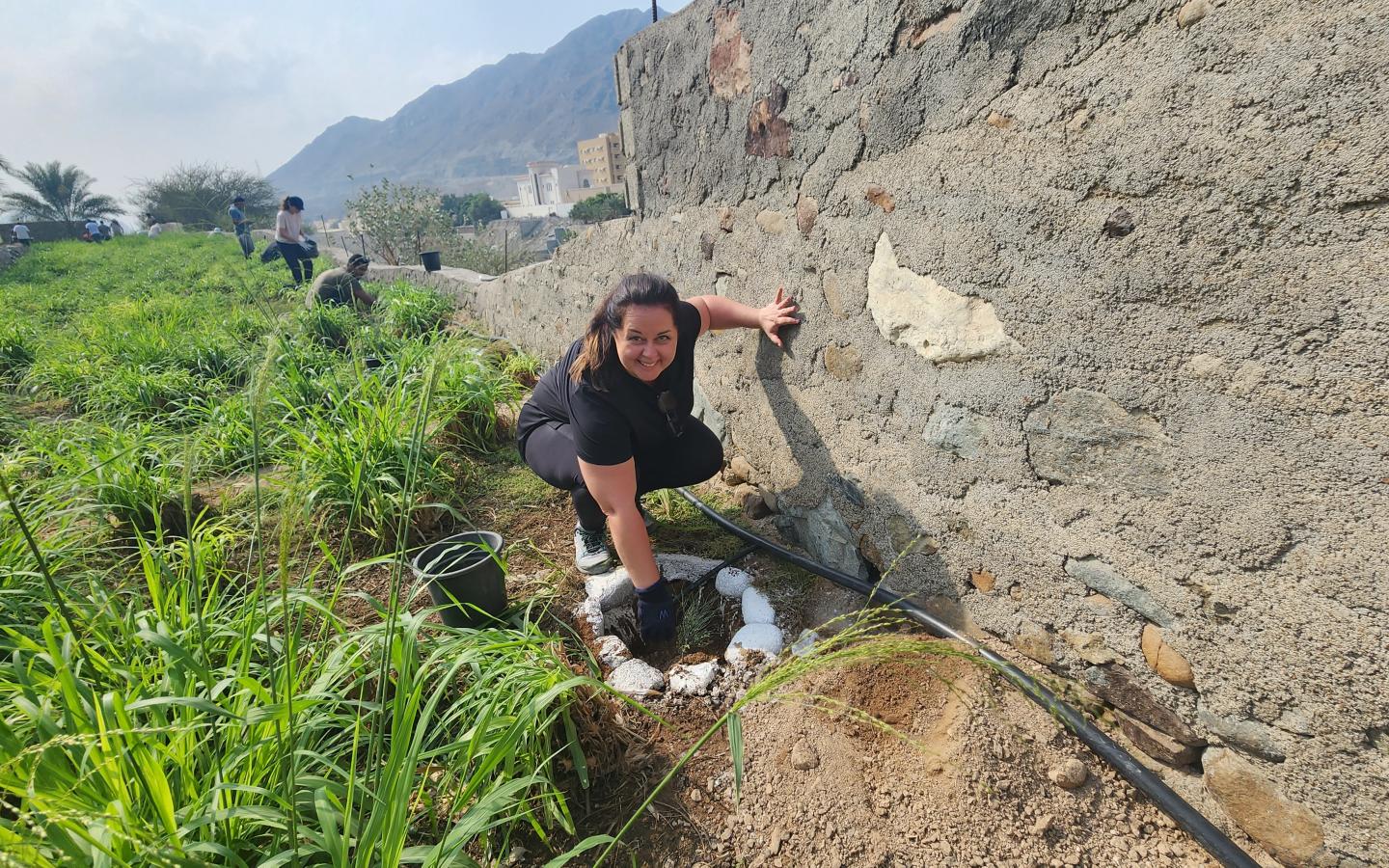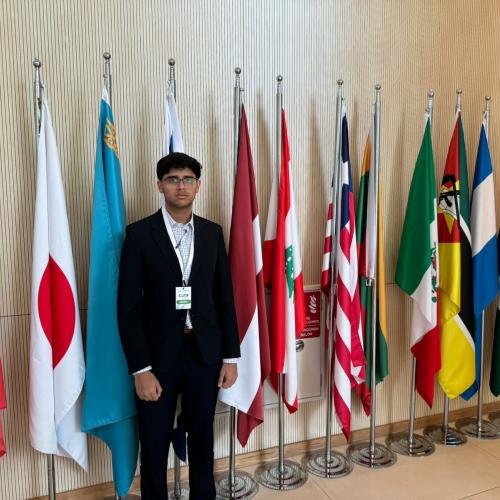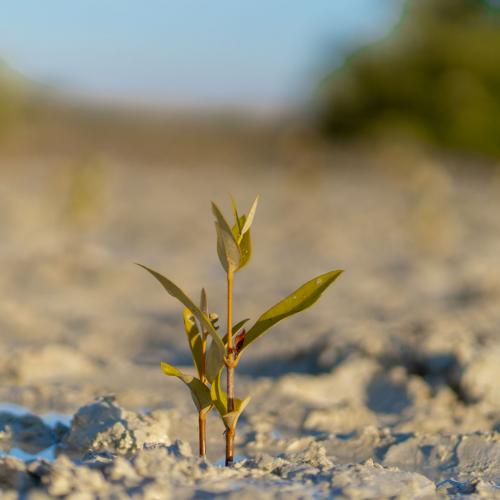World Environment Day 2024: In conversation with Emirates Nature-WWF biodiversity expert Dr. Andrew Gardner
World Environment Day 2024 draws attention to the critical issues of Land Restoration, Desertification and Drought Resilience, under the slogan “Our land. Our future.” It reminds us to prioritize the restoration of natural ecosystems. If we protect nature, nature protects us.
This was especially evident in recent months as UAE communities experienced extreme rainfall and flooding. During this time, environmental charity Emirates Nature-WWF shored up recovery and resilience-building efforts with support for an incredible community of Leaders of Change and volunteers from across the nation. 205 volunteers joined us in Al Bithnah (Fujairah), Masfout (Ajman) and Wadi Shees (Sharjah) to clear debris, restore farmlands and falaj irrigation channels and implement climate adaptation measures to increase protection against future adverse weather events.

To understand the links between nature loss and climate change, and the importance of conservation, we spoke to Dr Andrew ‘Drew’ Gardner, Associate Director of Biodiversity Conservation at Emirates Nature-WWF.
Q. What is the importance of World Environment Day?

World Environment Day underscores the importance of the natural environment for our survival. This year’s theme draws attention to the critical issues of Land Restoration, Desertification and Drought Resilience, under the slogan “Our land. Our future.”
It calls on everyone to protect biodiversity loss by supporting the Kunming-Montreal Global Biodiversity Framework (KMGBF). This involves encouraging governments, local communities, non-governmental organizations, policymakers, the business sector, and individuals to actively support the biodiversity agenda.
Everyone has a role to play and can therefore be part of the plan.
Q. Is desertification an issue that we face in the UAE?

As the UAE is situated in an arid land, one might think that desertification is not relevant. After all, most of the country is naturally desert, and the fauna and flora are desert adapted! However, desertification is extremely relevant.
For example, the natural vegetation found in the sand desert comprises perennial grasses and small shrubs. Where land is protected from livestock grazing, the difference between ungrazed and grazed areas is dramatic. Overgrazing by camels and goats removes the desert vegetation and the animals that depend on it, contributing to biodiversity loss and desertification. In more recent times, this has affected the regeneration of native trees such as sidr, shu’a (Arabian Moringa) and samur.
The camel population is thought to have increased around fivefold since 1970, with the total number of camels in the UAE estimated to be 549,000 (in 2021). This impacts the availability of food for other species, such as oryx, gazelle or gerbils for instance. A single camel relying on the desert for food uses the resources that would support 6 oryx, 30 gazelle or 12,500 gerbils!
A similar story of land degradation can be found in the Hajar Mountains. The mountains were formerly far greener and more wooded than they are now. A combination of factors has resulted in loss of tree cover including copper smelting in historic times, which used huge quantities of charcoal produced by felling trees. In more recent times, the regeneration of the native trees such as sidr, shu’a, and samur is largely affected by grazing of domestic and feral goats.
The other main cause of nature loss is habitat destruction, as natural lands and ecosystems are changed for urban, industrial or agricultural uses. New highways and developments fragment the landscape; while dredging, reclamation and beachside developments affect the seascapes.
Q. How does nature loss impact our daily lives and well-being?

Nature loss affects us in many ways. For example, it leads to the loss of ecosystem services such as clean air, clean water, and pollinators. Loss of native trees in mountain ecosystems severely affects the abundance of pollinators and bees which are so essential for our crops (and all native plants). This has a direct and negative impact on honey production, especially the loss of samur and sidr trees.
Loss of mangroves and salt marshes reduces carbon sequestration (the removal of carbon from the atmosphere). In fact, the loss of these habitats adds to atmospheric carbon as stocks stored in the sediments are released. This is the opposite of what we are aiming for as we tackle climate change.
Loss of green spaces and a disconnect from nature have been shown to impact mental health, increasing stress, anxiety, depression and an overall reduced quality of life. There is a growing recognition of the strong link between nature and human well-being, which we must now translate into actions to enhance and restore nature.
Q. How does Emirates Nature-WWF help restore natural ecosystems and biodiversity?

Preserving nature and biodiversity is at the core of our mission. We collaborate with our partners from government agencies, the private sector, and active members of civil society to implement a number of projects focused on enhancing biodiversity and restoring natural ecosystems in the country. These efforts also aim to boost the social and economic benefits associated with healthy and thriving ecosystems.
One notable initiative is our Nature-Based Solutions project in the UAE, which aims to build climate resilience. This project focuses on protecting, restoring, and managing vital coastal ecosystems, including mangroves, seagrasses, salt marshes, and oyster beds.
The Priceless Planet Coalition project is a global initiative through which we are restoring and regenerating 50,000 mangroves and associated coastal ecosystems in the UAE using an ecosystem-based approach.
We are also working with the government of Umm Al Quwain and the Ministry of Economy to develop guidelines and support the implementation of a Sustainable Blue Economy in Umm Al Quwain. This is a significant step towards building a sustainable marine economy that preserves and restores the diversity, productivity, and resilience of marine ecosystems.
Q. What does it mean to build resilience? Why is this so important for local communities?

It is important to ensure that local communities are better prepared for climate-related extreme weather events such as excess rainfall, flooding, drought and so on. We contribute to this through our Building Resilient Communities project, which demonstrates an agroecological and nature-positive approach to rural agriculture in the Hajar Mountains. This approach also preserves natural and cultural heritage.
The mountain villages and their farms are havens for fauna and flora. We aim to promote sustainable agriculture, preserve biodiversity and enhance the potential of eco-tourism. This includes renovating the old ‘falaj’ irrigation systems, introducing modern water-saving irrigation and solar pumps, and establishing informative nature and heritage trails.
In addition, we are encouraging the growth of native trees to support biodiversity, pollinators and honey production, and the planting of native shu’a trees as a valuable water-wise crop.
Q. How can individuals and members of society enhance the restoration of nature and resilience of communities?

Individuals across the UAE are welcome to participate in our nature restoration, conservation and citizen science activities through our Leaders of Change programme.
Leaders of Change is an annual programme that mobilizes UAE society to create change on the ground through trainings, ideation sessions and exciting conservation field trips. These activities are linked to our ongoing conservation work and align with the nation’s environmental goals.
In response to the recent extreme weather events, Leaders of Change dedicated all events over the past few weeks towards flood recovery and resilience building at sites where we implement conservation. We were delighted to witness 205 Leaders of Change and volunteers from all corners of the UAE join nature conservation experts in the villages of Al Bithnah (Fujairah), Wadi Shees (Sharjah) and Masfout (Ajman). Together, they removed 165.5 kg of debris and repaired 550 metres of falaj irrigation canals, ensuring a continuous flow of fresh water to the surrounding farmlands. Leaders of Change and volunteers also restored farmlands and 300 metres of nature trails in Masfout.
These efforts were not aimed at achieving merely temporary relief, but rather a lasting impact. Our Leaders of Change and civil society volunteers contributed significantly to climate change adaptation efforts such as the planting 120 local shu’a trees to improve soil health and enhance ecosystem stability. And the construction of 20 meters of berms in Wadi Shees—storm walls aimed at enhancing the climate resilience of farmland, safeguarding against future floods and related damage.



